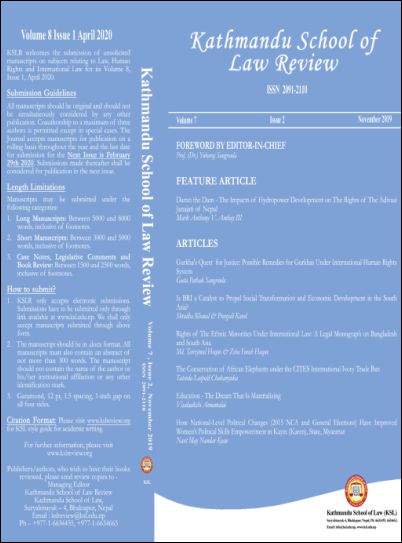Damn the Dam The Impacts of Hydropower Development on the Rights of the Adivasi Janajati of Nepal
Abstract
Nepal is rich in hydropower resources, with 83,000 MW worth of hydropower energy potential waiting to be tapped. The country currently generates only 968 MW of hydropower energy. The Government of Nepal is quite keen on developing these resources for supposed economic growth and progress. There are, however, very few studies that use a rights-based approach to illustrate the possible effects of hydropower development on Indigenous Peoples. Fewer still are studies that use the rights-based approach to demonstrate the effects of hydropower development on the Adivasi Janajati, Nepal’s Indigenous Peoples. This study is an attempt to bridge that gap. The research queries how hydropower development impacts the rights of the Adivasi Janajati in Nepal. The rights-based approach to hydropower development is used as a conceptual framework for studying and analyzing the said impacts. This study uses the case study approach to represent the said hydropower development impacts. Drawing on primary data from in-depth interviews and field research as well as secondary data gathered from various official documents, researches, reports, and news articles, this paper argues that, more often than not, hydropower development in Nepal violates the rights of the Adivasi Janajati. This study also asserts that the Adivasi Janajati have a deep connection to their ancestral lands, and loss of these ancestral lands will have devastating consequences for them. Finally, this research demonstrates that the rights-based approach to hydropower development is an effective tool in studying the impacts of hydropower development on Indigenous Peoples. This study can be utilized by government entities, advocacy groups, non-government organizations, and dam financiers and developers to more clearly understand what is at stake for and lost by the Indigenous Peoples in hydropower development. While Nepal is a party to the Indigenous and Tribal Peoples’ Convention and is a signatory to the United Nations Declaration on the Rights of Indigenous Peoples, it is clear that more needs to be done to secure the rights of the Adivasi Janajati in the country.
Downloads
Downloads
Published
How to Cite
Issue
Section
License
Copyright (c) 2019 Kathmandu School of Law

This work is licensed under a Creative Commons Attribution 4.0 International License.
© Kathmandu School of Law

